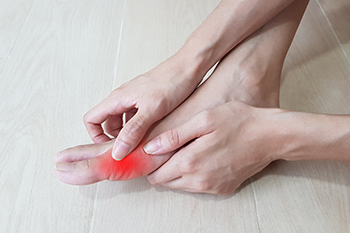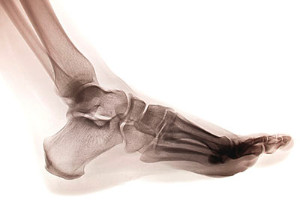Connect With Us
Blog
Items filtered by date: October 2022
It's Time for Beautiful Feet
All About Gout

Gout, a form of arthritis, is a painful inflammation of the joints that often develops in the big toe. Men aged about 40 or 50 and older adults who use diuretics are most commonly affected by gout. When the body is unable to rid itself of excess uric acid, small crystals may form that collect in the joints. The result is dramatic, sometimes happening overnight as the joint turns red, swells, and becomes very painful. Although gout can run in families, other factors may contribute to its development. Among them are excessive alcohol intake, not drinking enough water, obesity, and eating certain foods. One of the major ways to reduce the risk of gout is to change dietary habits. Refraining from food and beverages with high purine content, such as organ meat, red meat, seafood, and alcohol, can help. In addition, certain medications are known to help reduce uric levels. If you are experiencing symptoms related to gout, please seek the care of a podiatrist who can provide treatment options.
Gout is a painful condition that can be treated. If you are seeking treatment, contact one of our podiatrists from Southwest Podiatry. Our doctors will treat your foot and ankle needs.
What Is Gout?
Gout is a form of arthritis that is characterized by sudden, severe attacks of pain, redness, and tenderness in the joints. The condition usually affects the joint at the base of the big toe. A gout attack can occur at any random time, such as the middle of the night while you are asleep.
Symptoms
- Intense Joint Pain - Usually around the large joint of your big toe, and it most severe within the first four to twelve hours
- Lingering Discomfort - Joint discomfort may last from a few days to a few weeks
- Inflammation and Redness -Affected joints may become swollen, tender, warm and red
- Limited Range of Motion - May experience a decrease in joint mobility
Risk Factors
- Genetics - If family members have gout, you’re more likely to have it
- Medications - Diuretic medications can raise uric acid levels
- Gender/Age - Gout is more common in men until the age of 60. It is believed that estrogen protects women until that point
- Diet - Eating red meat and shellfish increases your risk
- Alcohol - Having more than two alcoholic drinks per day increases your risk
- Obesity - Obese people are at a higher risk for gout
Prior to visiting your podiatrist to receive treatment for gout, there are a few things you should do beforehand. If you have gout you should write down your symptoms--including when they started and how often you experience them, important medical information you may have, and any questions you may have. Writing down these three things will help your podiatrist in assessing your specific situation so that he or she may provide the best route of treatment for you.
If you have any questions, please feel free to contact our offices located in Dallas, and Carrollton, TX . We offer the newest diagnostic and treatment technologies for all your foot care needs.
Athlete’s Foot in the Laundry

Athlete’s foot is a specific kind of foot condition that is spread by a fungus and causes a scaly rash, especially between the toes. To prevent or mitigate the spread of the fungal infection, an individual might consider being particularly careful with how they handle their laundry. This is because spores can often spread from clothes to clothes. First, someone might try separating infected clothes from non-infected clothes. For example, if someone in the household has been exposed to athlete’s foot, one might separate that person’s clothes into a bin to be washed separately from the other clothes. When the infected batch of laundry is washed, one could use hot water for the infected laundry because cold water does not eliminate the fungus. The goal is to prevent the fungus from spreading to other materials in the wash. Contact a podiatrist today to learn more about preventing the spread of athlete’s foot.
Athlete’s foot is an inconvenient condition that can be easily reduced with the proper treatment. If you have any concerns about your feet and ankles, contact one of our podiatrists from Southwest Podiatry. Our doctors will treat your foot and ankle needs.
Athlete’s Foot: The Sole Story
Athlete's foot, also known as tinea pedis, can be an extremely contagious foot infection. It is commonly contracted in public changing areas and bathrooms, dormitory style living quarters, around locker rooms and public swimming pools, or anywhere your feet often come into contact with other people.
Solutions to Combat Athlete’s Foot
- Hydrate your feet by using lotion
- Exfoliate
- Buff off nails
- Use of anti-fungal products
- Examine your feet and visit your doctor if any suspicious blisters or cuts develop
Athlete’s foot can cause many irritating symptoms such as dry and flaking skin, itching, and redness. Some more severe symptoms can include bleeding and cracked skin, intense itching and burning, and even pain when walking. In the worst cases, Athlete’s foot can cause blistering as well. Speak to your podiatrist for a better understanding of the different causes of Athlete’s foot, as well as help in determining which treatment options are best for you.
If you have any questions please feel free to contact our offices located in Dallas, and Carrollton, TX . We offer the newest diagnostic and treatment technologies for all your foot and ankle needs.
Why Do Stress Fractures Occur?

A very small crack on a bone can be referred to as a hairline or stress fracture. Stress fractures often occur in the feet and can affect one or more of the twenty-six bones in each foot. These tiny cracks typically result from repetitive movement and can be common among runners or people who participate in sports like basketball, tennis, and ballet. The symptoms can develop gradually and consist of pain that may subside after resting the affected foot, and the area may be swollen or tender. Relief and treatment often begin with stopping the activity that caused the fracture, followed by having an X-ray performed which can determine the extent of the fracture. As the swelling decreases and the pain subsides, it is helpful to reintroduce weight-bearing activities gradually. Staying active helps to stimulate the recovery process but it is important to refrain from high-impact activities. Please contact a podiatrist as quickly as possible who can properly diagnose and treat stress fractures.
Activities where too much pressure is put on the feet can cause stress fractures. To learn more, contact one of our podiatrists from Southwest Podiatry. Our doctors can provide the care you need to keep your pain free and on your feet.
Dealing with Stress Fractures of the Foot and Ankle
Stress fractures occur in the foot and ankle when muscles in these areas weaken from too much or too little use. The feet and ankles then lose support when walking or running from the impact of the ground. Since there is no protection, the bones receive the full impact of each step. Stress on the feet can cause cracks to form in the bones, thus creating stress fractures.
What Are Stress Fractures?
Stress fractures occur frequently in individuals whose daily activities cause great impact on the feet and ankles. Stress factors are most common among:
- Runners
- People affected with Osteoporosis
- Tennis or basketball players
- Gymnasts
- High impact workouts
Symptoms
Pain from the fractures occur in the area of the fractures and can be constant or intermittent. It will often cause sharp or dull pain with swelling and tenderness. Engaging in any kind of activity which involves high impact will aggravate pain.
If you have any questions please feel free to contact our offices located in Dallas, and Carrollton, TX . We offer the newest diagnostic and treatment technologies for all your foot and ankle needs.
Dealing With Bunionettes

A bunionette is a bony bump on the base of the 5th, or pinky, toe. Bunionettes are not pretty and not always problematic, but they sometimes can cause severe pain. For instance, they can make trying on shoes more difficult. A callus may form at the site of the bunionette, as a result of rubbing against a shoe. In other cases, inflammation of the joint can join with the bunionette to produce pain. In many cases, a bunionette forms on only one foot, but may appear on both feet. If a bunionette becomes problematic, surgery is a treatment option. Non-surgical treatment includes avoiding pointy-toed shoes, which tend to aggravate the condition. One can also wear pads on the area to cushion the bone inside a shoe. Other non-surgical methods include orthotics, which correct gait problems and other side effects of having a bunionette, as well as certain medications to relieve pain. If you need assistance in dealing with a painful bunionette, please consult a podiatrist who can offer appropriate treatment options.
If you are suffering from bunion pain, contact one of our podiatrists of Southwest Podiatry. Our doctors can provide the care you need to keep you pain-free and on your feet.
What Is a Bunion?
Bunions are painful bony bumps that usually develop on the inside of the foot at the joint of the big toe. As the deformity increases over time, it may become painful to walk and wear shoes. Women are more likely to exacerbate existing bunions since they often wear tight, narrow shoes that shift their toes together. Bunion pain can be relieved by wearing wider shoes with enough room for the toes.
Causes
- Genetics – some people inherit feet that are more prone to bunion development
- Inflammatory Conditions - rheumatoid arthritis and polio may cause bunion development
Symptoms
- Redness and inflammation
- Pain and tenderness
- Callus or corns on the bump
- Restricted motion in the big toe
In order to diagnose your bunion, your podiatrist may ask about your medical history, symptoms, and general health. Your doctor might also order an x-ray to take a closer look at your feet. Nonsurgical treatment options include orthotics, padding, icing, changes in footwear, and medication. If nonsurgical treatments don’t alleviate your bunion pain, surgery may be necessary.
If you have any questions, please feel free to contact our offices located in Dallas, and Carrollton, TX . We offer the newest diagnostic and treatment technologies for all your foot care needs.

